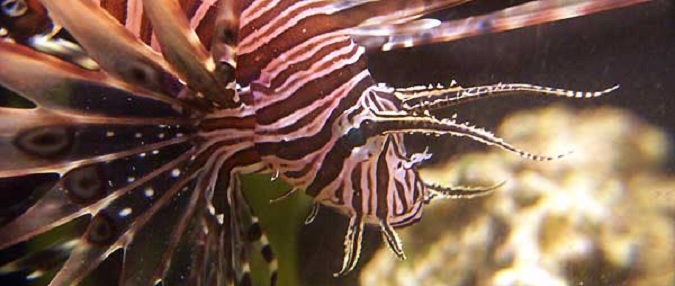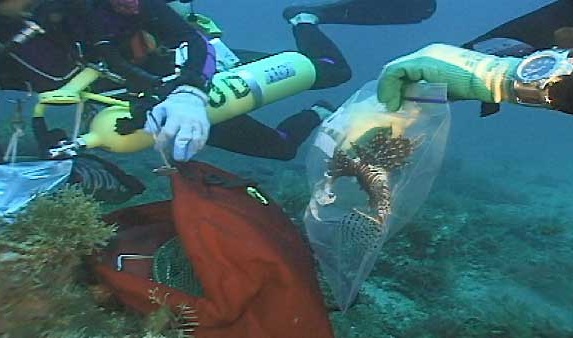
The lionfish (scientific name Pterois volitans) is a popular saltwater aquarium fish with distinctive maroon (or brown) and white stripes, fleshy tentacles above the eyes and below the mouth, and an imposing fan of prickly venomous spines. Although not fatal, the sting of a lionfish is extremely painful. Because these fish are not aggressive toward people, contact and poisoning is usually accidental. The species of lionfish now found in U.S. waters produce a mild poisoning.
The lionfish’s sharp, slender spines are located on the dorsal, anal, and pelvic fins. The venom is a combination of protein, a neuromuscular toxin, and a neurotransmitter called acetylcholine. The sting causes intense pain, redness and swelling around the wound site. Although the worst of the pain is over after an hour or two, some people report pain and tingling sensations around the wound for several days or weeks. On rare occasions, when the venom spreads to other parts of the body, people may experience headaches, chills, cramps, nausea, and even paralysis and seizures.
Lionfish are native to coral reefs in the warm, tropical waters of the South Pacific and Indian Oceans. They prey on a wide variety of smaller fishes, shrimps and crabs, and have few predators in their native range, where they occupy the upper levels of the food chain. At present, little is known about how other coral reef species in the lionfish’s “adopted” environment of the Atlantic Ocean might fare against them.
Lionfish also are believed to pose high risks to the local reef communities. As a predator of both economically and ecologically important species, lionfish a capable of disrupting the balance of reef communities. Lionfish are ambush predators and may use their outstretched, fan-like pectoral fins to “corner” their prey. Scientists are concerned that lionfish could seriously reduce the numbers of prey species and/or compete with other reef predators. When a new species is introduced in an area, it can take over the niche, or role, of a native species in its ecosystem, thus squeezing it out–this process is called competition. Another important factor is that native prey species lack of experience in confronting the intimidating lionfish might make the lionfish a more effective predator.
Can We Stop the Invasion?
Most scientists agree, it is unlikely that the lionfish’s invasion of U.S. waters can be reversed. Any large-scale attempts to remove the existing lionfish from U.S. Atlantic waters appear impractical and would be very costly, because of the large geographic range and depths that the fish now occupies. Lionfish are now found along the entire southeast U.S. coastline at depths between 1 and 1,000 ft, making their complete removal all but impossible. Scientists do believe, however, that lionfish can be controlled in some locations, such as some Caribbean islands and marine protected areas. The lionfish invasion highlights the complexity of managing introduced species in the marine environment. Lionfish now join the ranks of other aquatic invasive species that have taken up permanent residence in U.S. waters, such as European green crabs, snakeheads, and zebra mussels.
Scientists are attempting to answer the following questions:
• How does an “alien invasion,” like that of the lionfish, affect an ecosystem?
• Are lionfish in the Atlantic a problem?
Although scientists don’t know much about the ecological impact of lionfish in the Atlantic at this point, they know very well the impacts of many other invasive species. For example, scientists have studied one of the most infamous stowaways that has entered U.S. waters via ballast water, the zebra mussel. Originally from Europe, it now flourishes in the Great Lakes. Up to 700,000 zebra mussels may occupy only one cubic yard on the surfaces of boats, pilings and pipes. By 2000, these alien invaders had caused $5 billion damage to the infrastructure of industries, public utilities, ship navigation, boating and sport fishing.
Another example of a well-studied aquatic invader is purple loosestrife, a plant now common in wetlands throughout the U.S. and Canada. It was brought to North America from Europe in the 1800s – both accidentally and on purpose. Because it has no natural predators in North America, purple loosestrife is able to rapidly invade wetlands. Once established, purple loosestrife out competes and displaces many native species such as cattails. Because animals depend on native plants for food, nesting areas, and shelter, purple loosestrife invasions indirectly harm wildlife. Muskrats, bog turtles, and ducks are some of the species that suffer when purple loosestrife takes over.
So, what about the future of lionfish in U.S. waters?
Scientists predict that lionfish will continue to increase in abundance. In 2004, NOAA scientists collected 155 lionfish at 19 different locations. Some of these were juveniles and females ready to spawn (reproduce). These numbers far surpass their original expectations, and they now believe that lionfish are actually thriving in water depths over 120 ft off North Carolina. Scientists also predict that lionfish presence in United States waters, especially in the southeast, will become more noticeable, and more encounters between people and lionfish will probably lead to more stings. Because most observations of lionfish off the U.S. coast have been at depths of 100 ft or more, scuba divers are most likely to encounter them, but scientists caution that recreational and commercial fishermen will also be catching them in the future.
For now, scientists have five main suggestions:
• Track the lionfish population. Although more sightings in recent years suggest that more lionfish are present, that may not be the case. It could simply be that more public awareness has led to more reports. A monitoring program is needed to determine if the number of lionfish is actually growing.
|
• Conduct more research. Scientists’ ability to predict the lionfish’s future abundance, and its effects on the ecosystem is greatly hindered by a lack of knowledge. Research is needed to determine the lionfish’s ability to survive, reproduce, and grow in the Atlantic Ocean.
• Educate the Public. People need to know that it can be harmful to release aquarium fishes into bodies of water. In the United States and throughout the Caribbean, people should be alerted to the presence of lionfish and encouraged to report sightings. At the same time, people should be cautioned against handling lionfish and made aware of the health risks from their stings.
• Notify physicians and other health care providers about venomous fish in U.S. waters. One study of reported lionfish stings, mostly involving aquarists, noted no fatalities. Most stings result in uncomplicated wounds with severe local pain that responds well to soaking treatment. A greater risk appears to be secondary infection resulting from the wound. In addition to medical personnel and health-care providers, boat operators and lifeguards also need to be advised about lionfish stings.
• Make regulations to control the introduction non-native marine species. Bermuda’s approach, which is to enforce a strict ban on the importation of live fish, is proving an especially effective way to reduce the risk of aquarium releases. But scientists caution that the issue is more complex than simply limiting imports of non-native species. Some believe that such efforts will fail unless we learn more about how these species disperse once they are introduced into non-native waters. Although the lionfish invasion is probably here to stay, this dramatic event may prompt the development of effective strategies to reduce the ill effects of other marine invaders.

